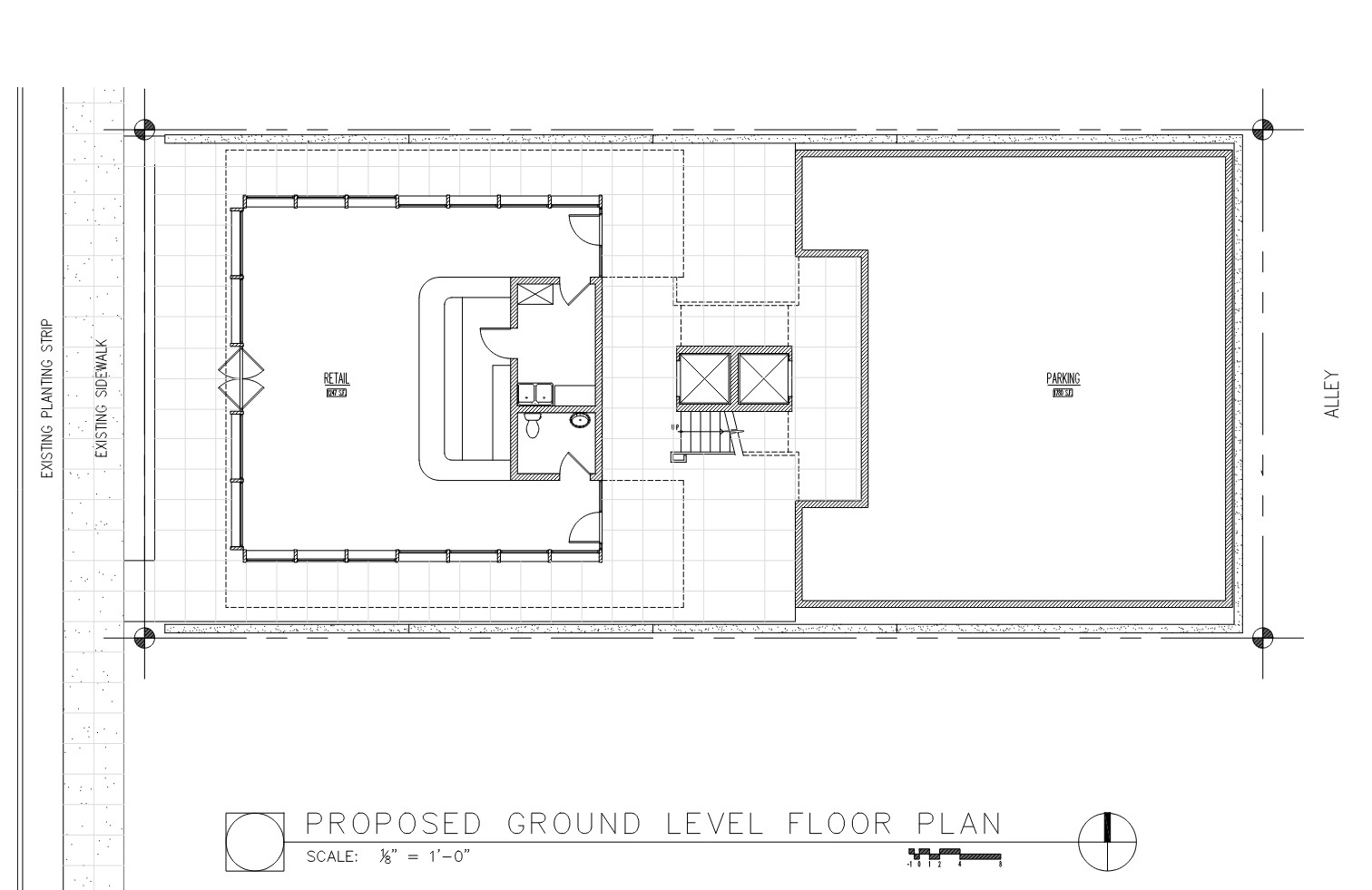12 Building Better: A Case Study Analysis of Mass Timber vs. Traditional Construction Methods in Seattle
John Ales
1. Introduction
Seattle’s housing challenges and climate goals are converging in ways that demand new approaches to how buildings are designed and constructed. Mass timber—an engineered wood product known for its structural strength and lower carbon footprint—is gaining traction as a potential solution. This material offers faster build times and measurable environmental benefits, yet adoption remains limited due to industry hesitation and technical barriers.
This case study examines how emerging digital tools like Branch 3D Concept Lite by StructureCraft[1] can streamline the design process by allowing architects to test structural concepts early, without waiting on engineering feedback. That kind of time savings matters, especially in multi-family housing, where cost and speed often determine project feasibility. At the same time, we explore how mass timber construction can support Seattle’s broader sustainability efforts by storing carbon rather than producing it.
This research aims to examine the design of a new mid-rise residential project constructed with mass timber, comparing its costs and environmental footprint to those of conventional methods, such as wood platform framing and concrete-steel construction. It asks a central question: Can mass timber, when paired with modern design software, offer a practical, lower-carbon path forward for Seattle’s housing market?
2. Rationale for Studying the Case
“Mass timber offers this alternative means of construction, which potentially has far better environmental consequences… it really is changing the conversation around how we think about sustainable materials.”
— Tyler Sprague, PE, University of Washington.
Seattle is experiencing steady population growth, yet new housing isn’t being built fast enough to meet the rising need, leaving many priced out[2], [3]. Meanwhile, the city has committed to bold climate targets, including eliminating emissions from buildings as part of a broader effort to address climate change[4]. The combined urgency of the housing shortage and environmental responsibility signals that traditional construction approaches are not currently keeping up with the need for housing.
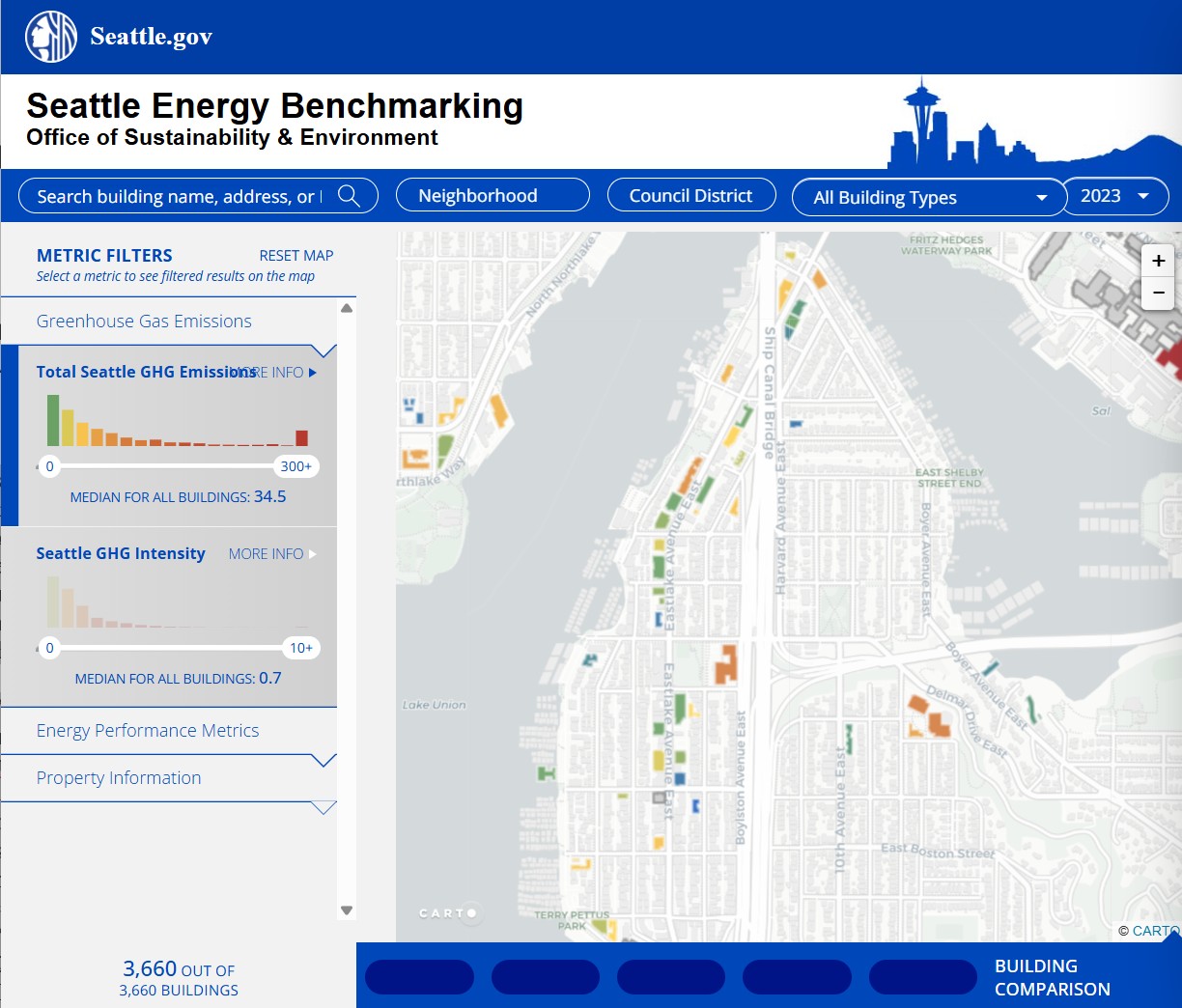
This is where mass timber can potentially offer a powerful counterpoint to traditional building systems, such as concrete and wood platform construction. Unlike steel and concrete, which are responsible for substantial embodied carbon, mass timber products such as dowel-laminated timber (DLT), cross-laminated timber (CLT), and glue-laminated beams (glulam) store carbon rather than emit it[5], [6], [7]. According to a report by the Carbon Leadership Forum[8], every cubic meter of CLT stores nearly one ton of CO₂, offering significant carbon savings when scaled across a large structure.
However, material choice alone cannot address the inefficiencies that delay project delivery. The architectural, engineering, and construction (AEC) industry is often slowed by fragmented workflows between disciplines, especially during schematic design. Typically, structural engineers are brought into a project only after architects have generated early concepts. Yet, it’s precisely during this early conceptual phase that critical decisions are made that can have a significant impact on the structural systems used in a project. Redesign loops and value engineering cycles add cost and time, often delaying project start dates and compromising design intent.
This case study argues that combining mass timber with design-integrated software, specifically Branch 3D software by StructureCraft.[1] It has the potential to address both sets of challenges. The rationale is simple: faster coordination and sustainable material selection are not mutually exclusive. In fact, when done well, they reinforce each other.
3. Motivation for the Problem / Research Question
“Digital tools are really crucial to enabling that level of coordination that mass timber requires… site work is simple, but everything must be coordinated ahead of time.”
— Tyler Sprague, PE, University of Washington
In Seattle’s competitive development environment, time is money, and delays often begin at the earliest stages of the design process. As a PhD student and registered architect working on multifamily housing design issues, I’ve observed firsthand how slow and segmented coordination between disciplines can stall progress. It’s not uncommon for architects to spend weeks iterating on schematic layouts, only to have structural engineers flag feasibility concerns that send them back to the drawing board.
The opportunity lies in integrating these two areas of innovation: using mass timber for its environmental and structural benefits and pairing it with digital tools that reduce coordination inefficiencies. Branch 3D software promises to bridge the gap between architectural concepting and structural feasibility by allowing real-time analysis of framing systems during schematic design. When used effectively, this tool can shorten design iteration loops, free up structural engineer capacity for higher-value decision-making, and bring sustainable designs to market faster.
The guiding research question for this case study is therefore:
How does mass timber, when integrated with early-phase digital design tools like Branch 3D, compare to traditional concrete and steel structural systems in terms of construction efficiency, coordination time savings, and environmental performance for mid-rise multifamily housing in Seattle?
This question is rooted in both a practical design challenge and a systems-level inquiry into how design workflows must evolve to meet 21st-century demands, framing the case study not only as a material comparison but also as a case study in its own right.
4. Project Description & Scope
This case study examines the conceptual design and analysis of a seven-story multifamily housing project located on a real-world site in Seattle, Washington. The building is designed to occupy approximately 22,000 to 26,000 square feet and house between 36 and 42 residential units, with commercial space located on the ground level. The project is planned for an urban infill lot measuring 110 feet by 50 feet, with zoning that aligns with the new code provisions established under Washington State’s HB 1110 legislation [9], [10]. This legislation enables “missing-middle” housing typologies, allowing for higher densities in areas previously designated for single-family homes only.
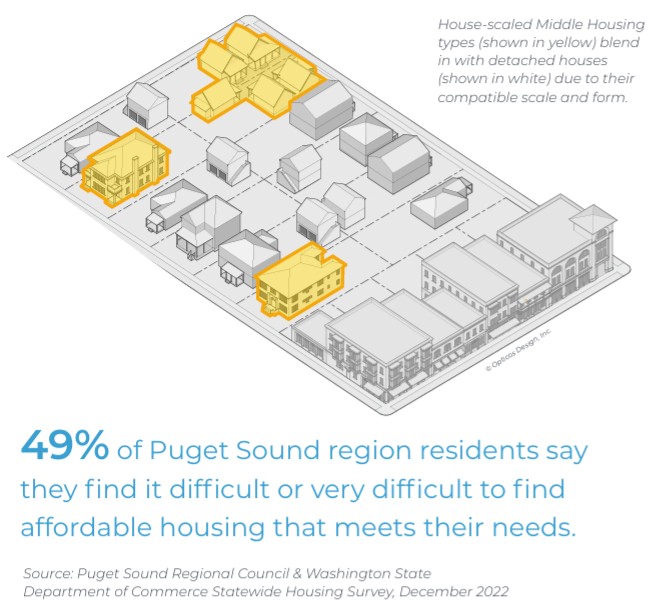
To ensure a focused and meaningful case study, the project restricts its scope to three structural systems: mass timber (primarily dowel-laminated timber with glulam framing), conventional concrete, and steel construction types. Originally, concrete and steel systems were not planned to be studied. Still, they were later included because they can support a seven-story building, whereas traditional wood-framed construction cannot.
This project was developed using four core design tools: Hand sketching to generate the preliminary design concepts, SketchUp for architectural concept modeling, Branch 3D for structural analysis and framing configuration, and AutoCAD for schematic plan development. These tools were chosen for their compatibility and their ability to reflect evolving industry workflows where architects are expected to deliver concept designs with increasing structural clarity.
All findings and conclusions presented here are based on schematic-level design and simulation; no final construction documents were produced. Any estimates are qualitative and comparative, based on typical ranges for labor, materials, and soft costs as reported in regional studies, practitioner interviews, and personal experiences from previous projects.
5. Methodology
“Digital tools are crucial to enabling that level of coordination that mass timber requires… site work is simple, but everything must be coordinated ahead of time.”
— Tyler Sprague, PE, University of Washington
This project relied on four primary tools that shaped the design process at each stage: early ideas were sketched by hand, volumetric studies and spatial layouts were developed in SketchUp, structural strategies were tested and adjusted using Branch AEC, and detailed schematic plans were completed in AutoCAD. Each tool was selected for its compatibility with the others and for its relevance to current trends in practice, where architects are increasingly tasked with producing concept designs that incorporate structural thinking from the outset.
A. Workflow: Tracing the Path from Concept to Structure
I started by sketching out initial layout ideas by hand, which helped clarify relationships between spaces. These sketches were then translated into SketchUp models to explore building form, unit arrangement, and circulation flow. Once a basic massing was in place, I moved the model into Branch 3D to test how the design would hold up structurally, checking aspects such as DLT spans, glulam framing layout, and shear wall positioning while there was still room to iterate. In the final stage, I turned to AutoCAD to fine-tune the drawings and ensure that the structural framework was fully integrated with the schematic layout.
B. Process Reflection: Shifting Toward Structurally-Informed Design
Branch 3D was unfamiliar territory at the start, but its visual interface made it surprisingly approachable. Initially, being required to factor in structural decisions so early felt limiting, but that perspective shifted as the benefits became apparent. Incorporating framing logic during the early design stages led to clearer, more intentional choices. The process ultimately brought architecture and structure into better alignment, helping to transform abstract ideas into something more grounded and buildable.
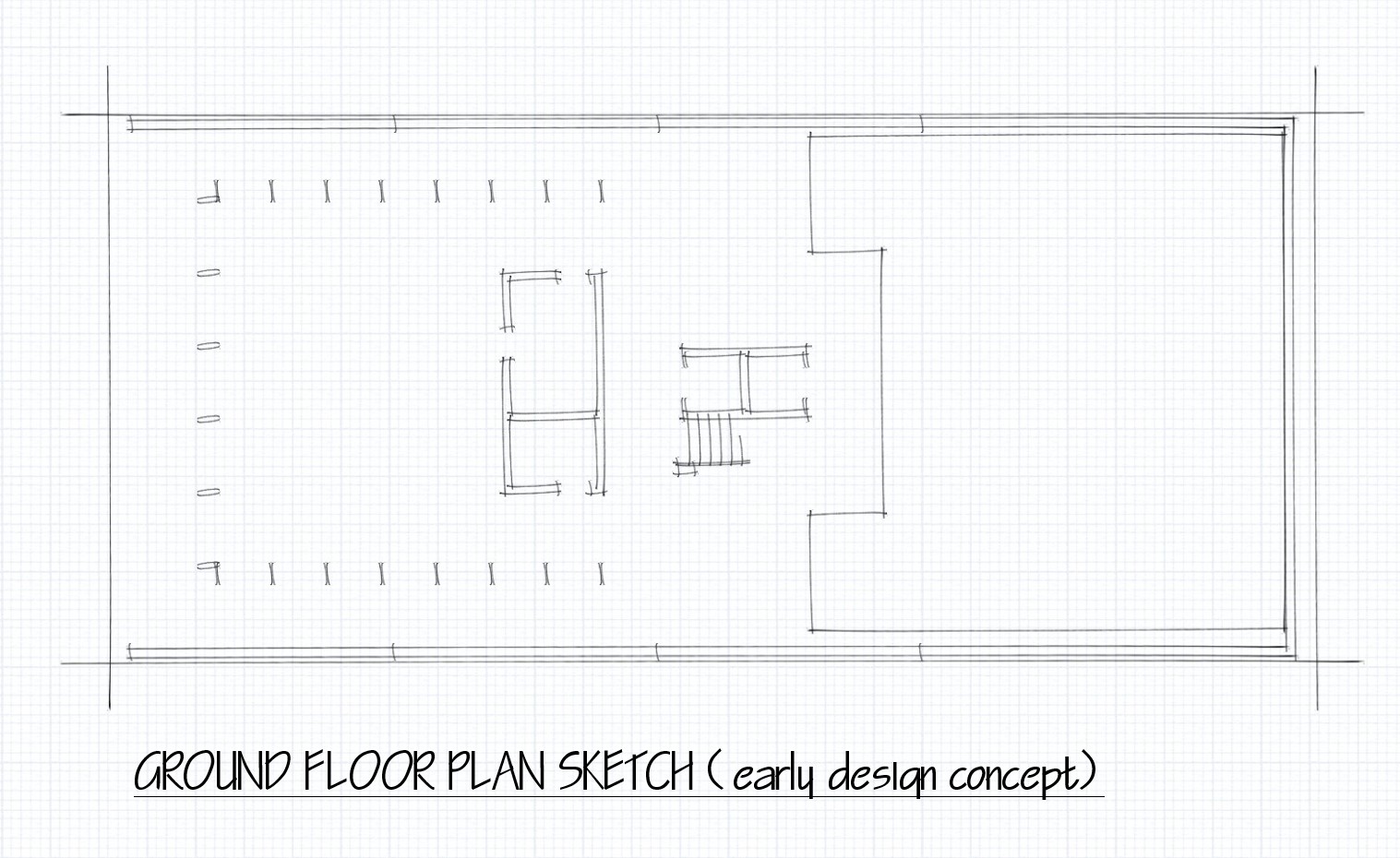
Conceptual sketch of the Ground Floor Plan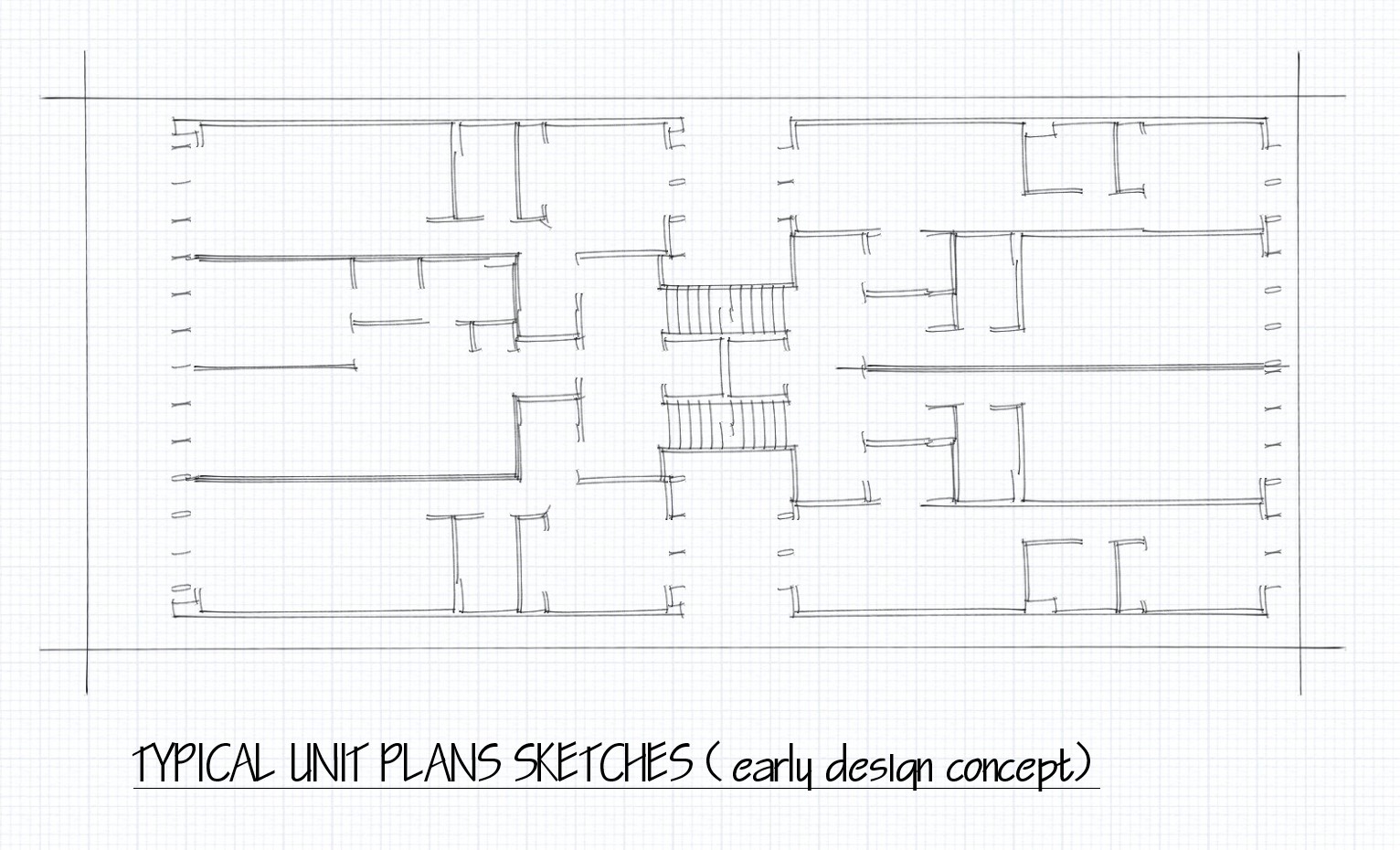
Conceptual sketch of the unit layout floor plans.
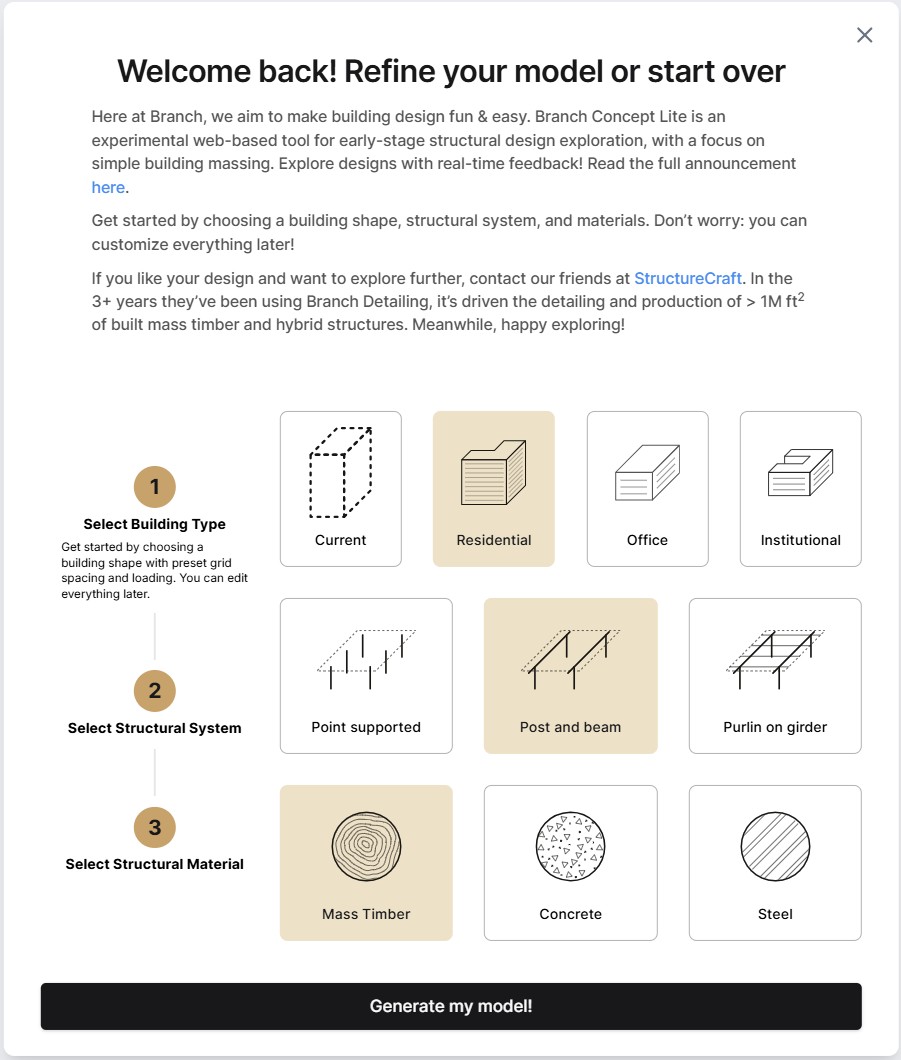
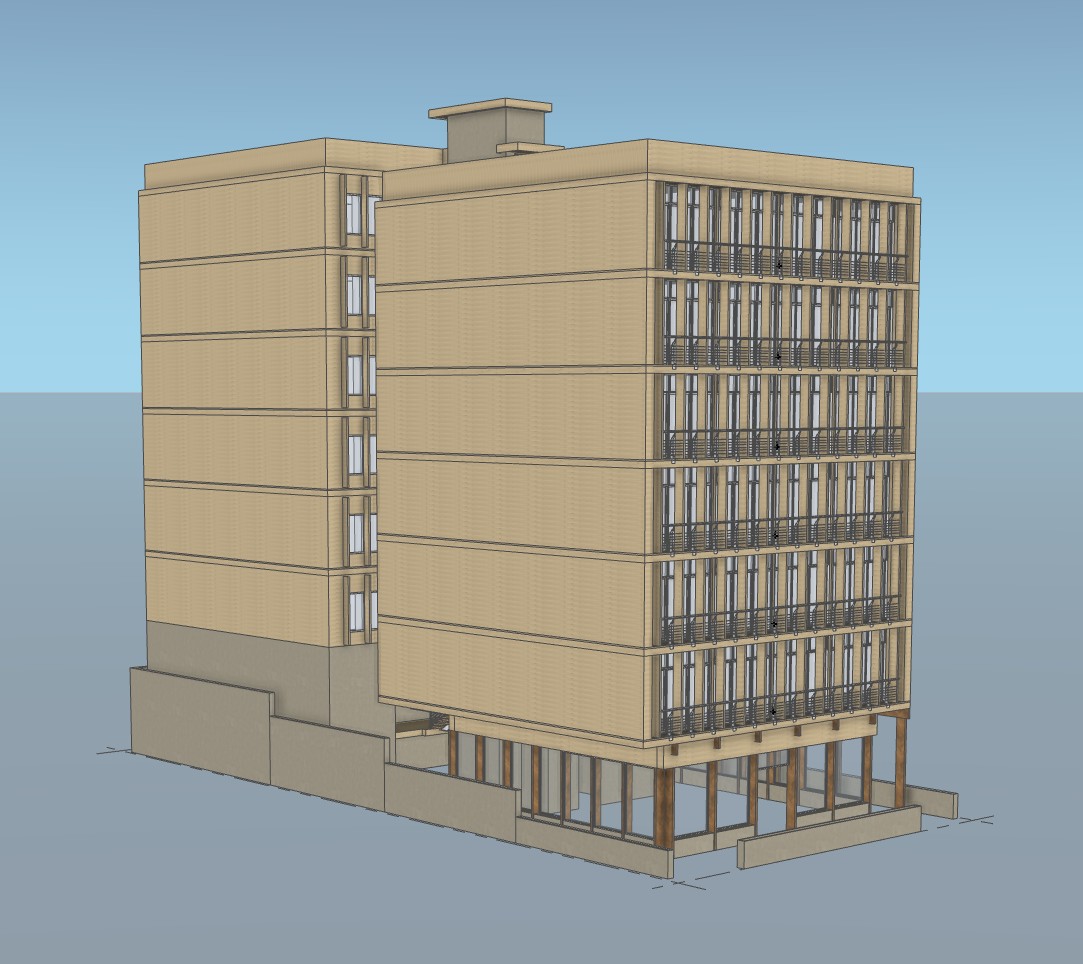
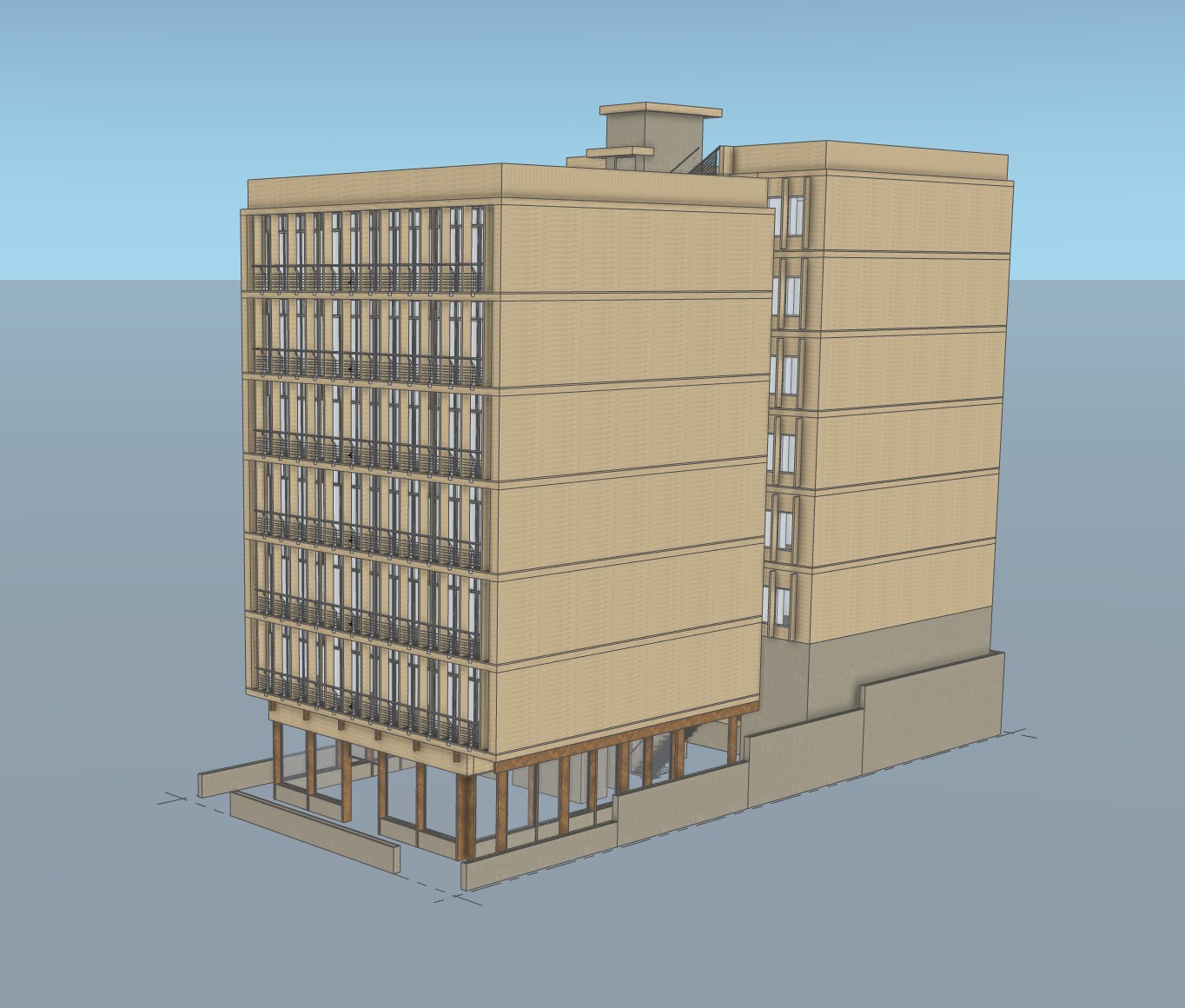
Schematic Design AutoCAD ground level floor plan.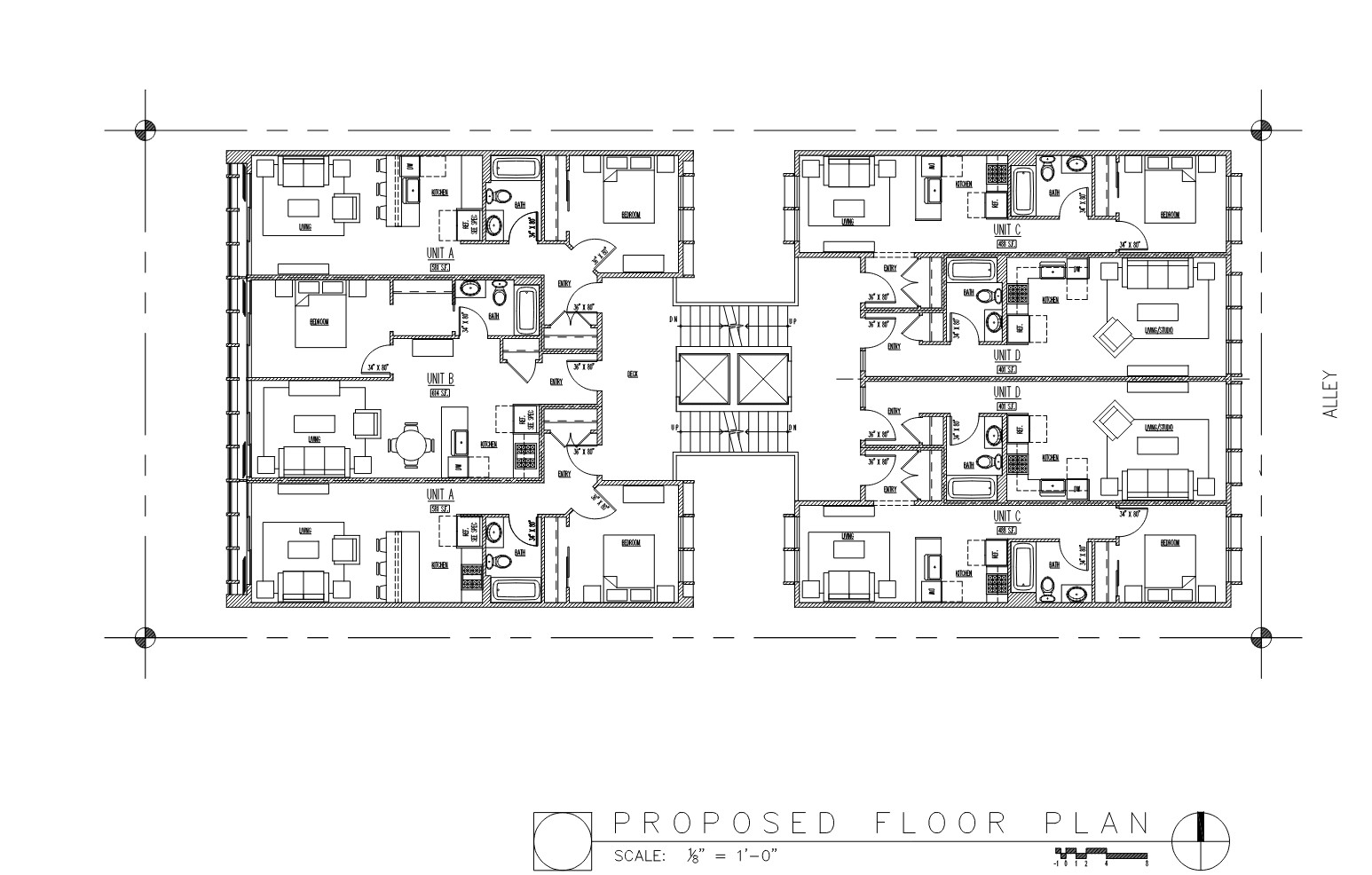
Schematic Design AutoCAD Typical Unit plans.
6. Case Study Facts & Early Results
The study evaluated several structural design paths for the seven-story multifamily residential structure: one utilizing mass timber construction and the other employing more traditional methods with concrete and steel. Traditional wood framing was excluded because the site slopes 12 feet from front to back, allowing for a seventh floor that is not allowable with conventional wood framing. The mass timber option utilized dowel-laminated timber (DLT) floor panels and a structural system comprising glued-laminated (glulam) beams and columns. These elements were modeled and tested in Branch 3D, facilitating an early-stage assessment of their structural performance. In contrast, the conventional schemes were evaluated using standard structural logic with concrete and steel systems modeled in Branch 3D. All of the options were able to obtain the same unit count and site configuration, but their performance diverged significantly when assessed in terms of coordination efficiency, structural feasibility, and sustainability.
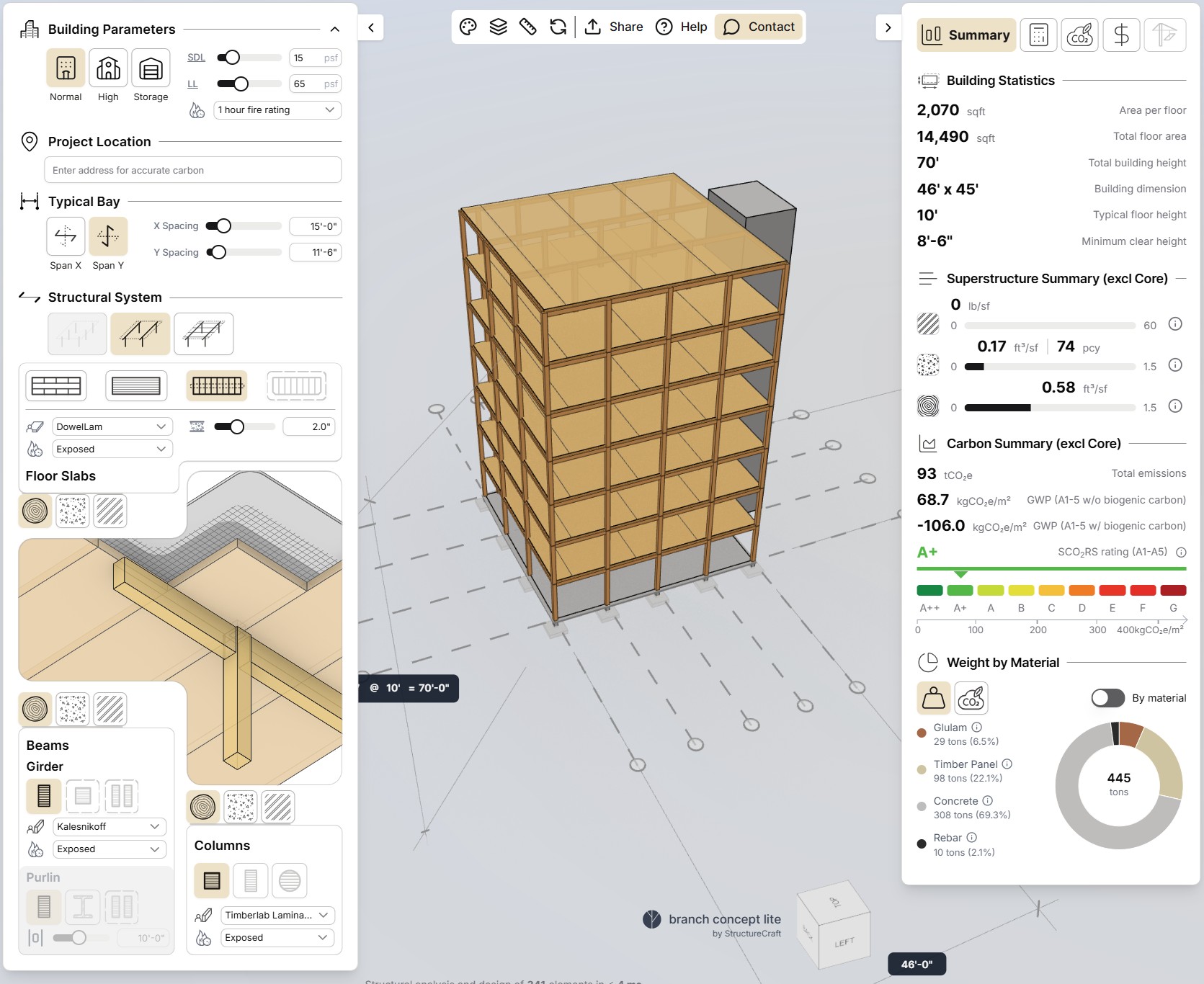
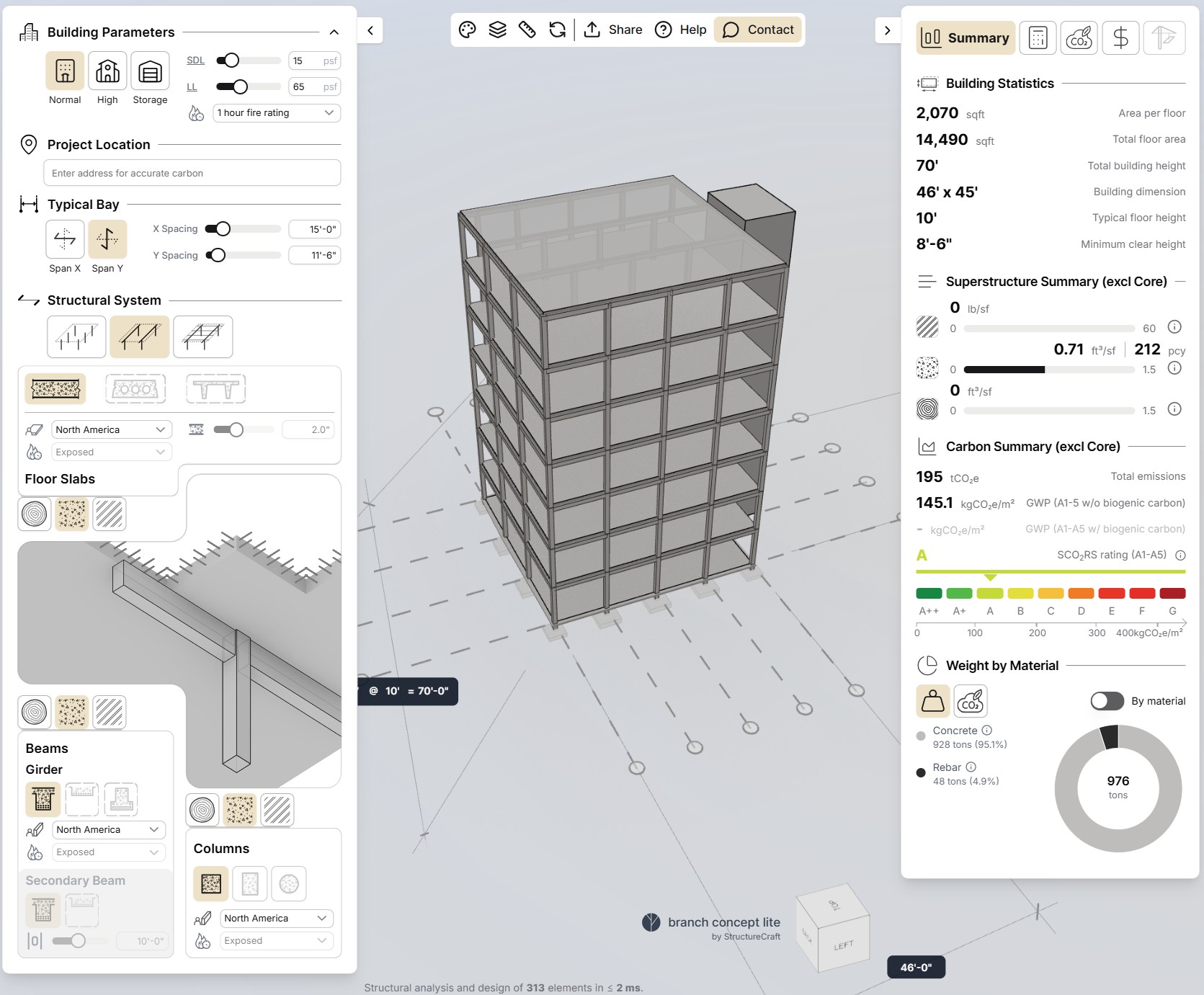 Branch 3D image showing the Concrete structural system building option.
Branch 3D image showing the Concrete structural system building option.
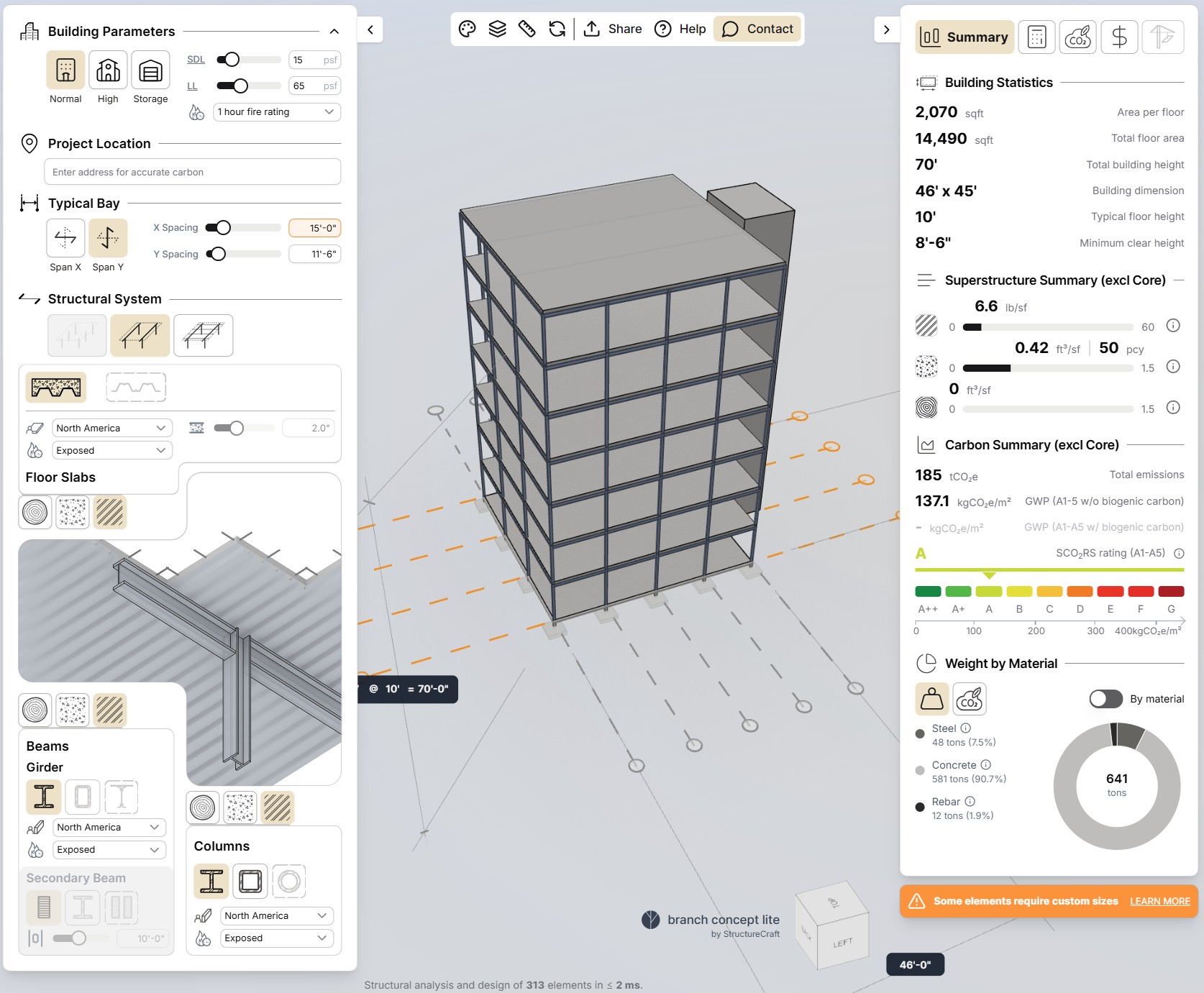 Branch 3D image showing the Steel structural system building option.
Branch 3D image showing the Steel structural system building option.
The project explored three distinct versions of the building, contrasting mass timber with traditional platform framing approaches. The mass timber design, featuring DLT floors paired with glulam beams and columns, demonstrated remarkable efficiency when analyzed in Branch 3D. Thanks to prefabrication and streamlined assembly processes, the mass timber version showed potential for significantly faster construction timelines compared to conventional methods that rely on sequential installation of load-bearing walls and framing elements. Some of the key takeaways are:
- Framing Efficiency and Coordination Time Savings
Branch 3D reduced schematic coordination time by approximately 20–30%, allowing architectural and structural concepts to evolve concurrently. Traditional workflows required multiple review cycles, delaying the resolution of structural conflicts. Additionally, while working with Branch 3D, I explored options that considered six- and seven-story buildings, as the site features a 12’ elevation change from front to back, allowing for an additional story while staying within the 65’ height limit. This extra story is not possible with traditional wood platform construction, but it is with mass timber, concrete, and steel. Therefore, the focus of the study shifted to these three materials during its development. - Sustainability Metrics and Carbon Analysis
The analysis from Branch 3D showed the mass timber design captured between 675 and 825 metric tons (for both buildings) of CO₂, calculated using standard industry carbon metrics and material quantities. The concrete and steel alternatives not only produced more carbon emissions but also demanded substantially larger foundation systems due to their increased weight. - Early Economic Observations
Preliminary cost comparisons suggest a 10–15% premium for mass timber materials, partially offset by reduced construction time and labor. Fewer revisions and better design integration also contributed to projected soft cost savings.
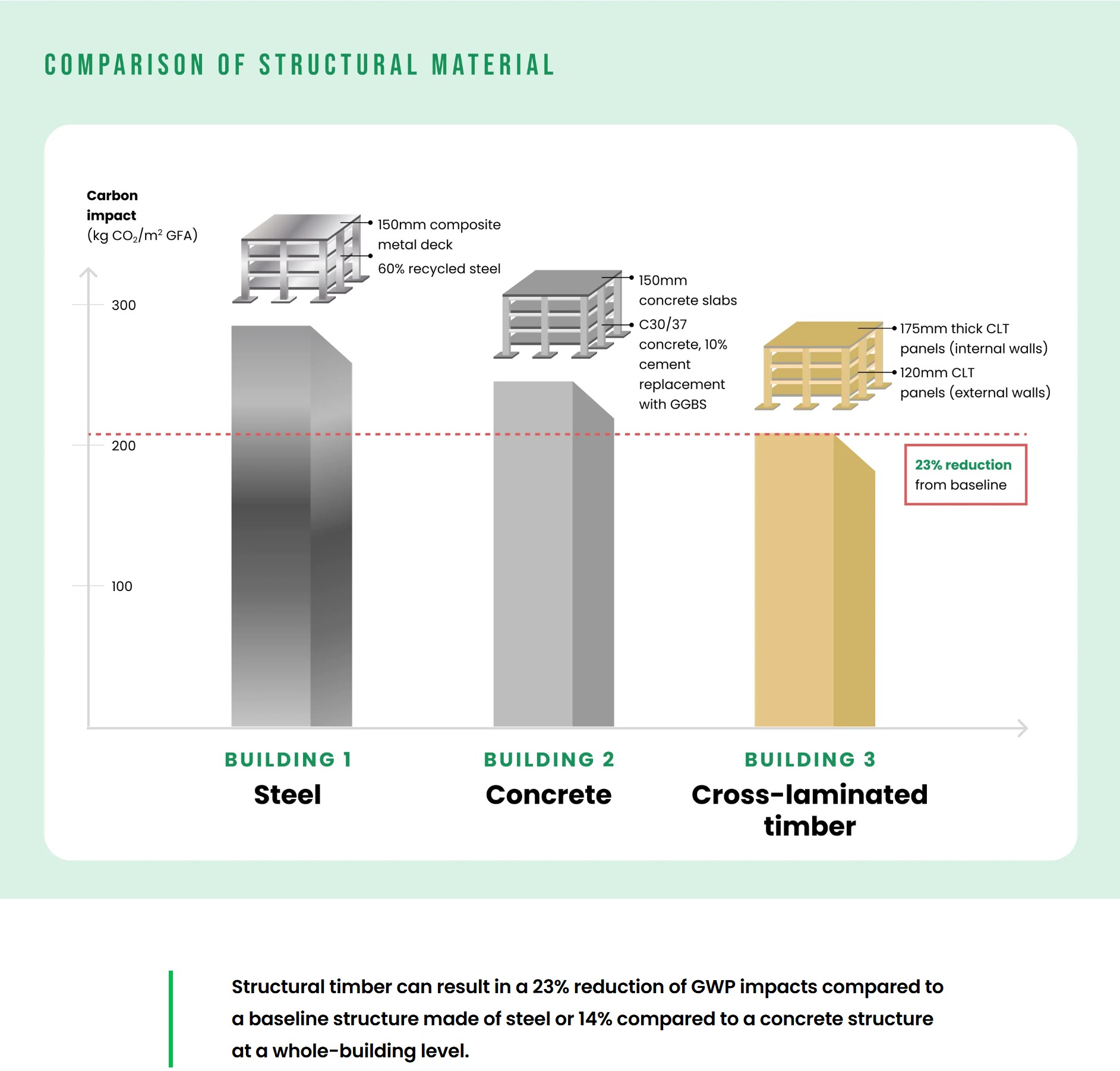
7. Patterns, Theoretical Contexts, and Analysis
“The technical challenges of mass timber are more exciting than obstacles. They drive innovation and design interest.”
— Tyler Sprague, PE, University of Washington
This case study aligns with innovation diffusion theory, which explains the slow adoption of innovations despite their clear performance benefits. Branch 3D’s effectiveness with mass timber building systems depends on early adopters willing to navigate its learning curve.
Neff and Dossick’s theory of “messy talk”[11] describes innovation as emerging from collaborative, unstructured exchange. Branch 3D brings this dynamic into schematic design, integrating architecture and structure before traditional handoffs occur.
The tool also supports the principles of Integrated Project Delivery (IPD), promoting early alignment between design goals and engineering logic. In educational settings, this reorients priorities, favoring technical coordination over visual speculation and preparing designers for more integrated practice.
8. Policy Context and Market Implications
Washington’s HB 1110[9], [12] and Seattle’s single-stair zoning updates[13] allow for higher-density housing and simplified egress configurations. These policy shifts support mass timber by making smaller, tighter footprints more viable.
However, regulatory conservatism and inconsistent permitting expertise continue to limit adoption. Mass timber is approved under IBC Type IV, but unfamiliarity with fire safety and the complexity of detailing remain barriers.
Policy must evolve in tandem with practice. Faster permitting for low-carbon buildings, continuing education for reviewers, and design incentives could help mass timber scale. Branch 3D can be part of this shift by making timber systems more legible and approvable in early phases.
9. Conclusion & Implications
“Branch 3D brings together spatial quality with databases of producers, carbon data, and fabrication info… I think it’ll be an extremely useful tool in the future.”
— Tyler Sprague, PE, University of Washington
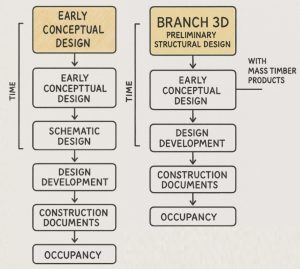
This case study demonstrated that combining mass timber construction with Branch 3D AEC software can significantly improve both design efficiency and environmental outcomes. By integrating structural feedback into the early stages of design, schematic development time was shortened by an estimated 25–30%, based on direct comparisons with conventional coordination timelines. The ability to test span capacity and load path logic in real time removed many of the delays associated with iterative consultant review cycles. This not only sped up the process but also reduced design ambiguity, enabling faster transitions from conceptual layouts to buildable solutions.
From an environmental standpoint, the use of mass timber contributed to measurable carbon performance benefits. Using volume-based calculations and carbon equivalence data from the Branch 3D software, the mass timber structure was estimated to sequester between 675 and 825 metric tons of carbon dioxide, depending on the final material specification and the extent of framing. This advantage is rooted in the fact that harvested wood products continue to store carbon throughout their service life, providing a stark contrast to conventional construction systems, which are typically carbon-intensive to manufacture and assemble.
Branch 3D software significantly reshaped the way structural decisions were integrated into the design process. Instead of approaching structural feasibility as a separate, later-phase consideration, the platform enabled architectural layout and structural logic to develop side by side from the outset. This real-time feedback loop allowed me to evaluate structural strategies, material constraints, and vertical load paths during the early stages of design—well before documentation or consultant input typically begins. As a result, structural clarity emerged alongside the architectural vision, leading to more cohesive and technically grounded design decisions.
With Seattle facing both a housing shortage and ambitious climate goals, mass timber construction combined with modern digital design tools presents a practical path forward. This innovative building approach offers an efficient, sustainable template that could reshape residential development, with the greatest impact seen in buildings ranging from five to eight stories tall. Mass timber not only allows for faster assembly due to prefabrication but also supports significant reductions in embodied carbon. When paired with tools like Branch 3D AEC, which streamline coordination and improve early-phase accuracy, the overall process becomes more efficient. This can help reduce soft costs, shorten project timelines, and align better with the city’s climate action goals, which call for net-zero emissions from new buildings by 2030, as outlined in Seattle’s Climate Action Plan.
However, for this model to be deployed more widely, broader institutional support will be necessary. This includes continued code adaptations for mass timber (such as those already reflected in the 2021 IBC), streamlined permitting processes, and incentives for low-carbon construction. The intersection of emerging software and sustainable materials represents a promising frontier, but its full potential depends on parallel shifts in policy, training, and market adoption.
10. References
[1] “Branch | Revolutionizing AEC Software,” Branch. Accessed: Jun. 03, 2025. [Online]. Available: https://www.branch3d.com
[2] “Housing Affordability – RSJI | seattle.gov.” Accessed: Jun. 10, 2025. [Online]. Available: https://www.seattle.gov/rsji/racial-equity-research/housing-affordability
[3] C. Clow, “Seattle housing shortage exposes gulf between state, local leaders,” HousingWire. Accessed: Jun. 10, 2025. [Online]. Available: https://www.housingwire.com/articles/seattle-housing-shortage-gulf-between-state-local-leaders/
[4] “Climate Change – Environment | seattle.gov.” Accessed: Jun. 10, 2025. [Online]. Available: https://www.seattle.gov/environment/climate-change
[5] T. Searchinger, L. Peng, R. Waite, and J. Zionts, “Analyzing Mass Timber’s Climate Impact | World Resources Institute”, Accessed: Jun. 10, 2025. [Online]. Available: https://www.wri.org/insights/mass-timber-wood-construction-climate-change
[6] Roy Anderson et al., “2025 International Mass Timber Report,” International Mass Timber Conference, Portland, OR, Annual Publication, 2025. Accessed: Jun. 03, 2025. [Online]. Available: https://masstimberconference.com/report/
[7] A. Taylor, H. Gu, P. Nepal, and R. Bergman, “Carbon Credits for Mass Timber Construction,” BioProducts Business, Apr. 2023, doi: 10.22382/bpb-2023-001.
[8] “Carbon-Storing Materials,” Carbon Leadership Forum. Accessed: Jun. 11, 2025. [Online]. Available: https://carbonleadershipforum.org/carbon-storing-materials/
[9] “House Bill 1110 – Middle Housing,” Your Voice Renton. Accessed: Jun. 10, 2025. [Online]. Available: https://yourvoice.rentonwa.gov/house-bill-1110
[10] “Seattle Just Rezoned Entire City — That Was the Easy Part – The Urbanist.” Accessed: Jun. 10, 2025. [Online]. Available: https://www.theurbanist.org/2025/05/27/seattle-just-rezoned-the-entire-city/
[11] C. Dossick and G. Neff, “Messy talk and clean technology: communication, problem-solving and collaboration using Building Information Modelling,” The Engineering Project Organization Journal, vol. 1, pp. 83–93, Jun. 2011, doi: 10.1080/21573727.2011.569929.
[12] “https://missingmiddlehousing.com/characteristics/.” Accessed: Jun. 11, 2025. [Online]. Available: https://missingmiddlehousing.com/characteristics/
[13] “Seattle — The Second Egress: Building a Code Change.” Accessed: Jun. 11, 2025. [Online]. Available: https://secondegress.ca/Seattle
Media Attributions
- Seattle Energy Benchmarking © City of Seattle
- Missing Middle Housing © Puget Sound Regional Council
- Sketch Ground Floor Plan_2 © John Ales
- Sketch Typical Floor Plan_2 © John Ales
- Branch 3D Welcome screen © Brach 3D by StructureCraft
- SD SkethUp Model 02 © John Ales
- SD SkethUp Model 01 © John Ales
- AutoCAD Ground level plan © John Ales
- AutoCAD Typical Unit plans © John Ales
- Option 01-Mass Timber © John Ales
- Option 02-Concrete © John Ales
- Option 03-Steel © John Ales
- Carbon Material Comparison © One Click LCA is licensed under a All Rights Reserved license
- Design Flow Chart © John Ales

